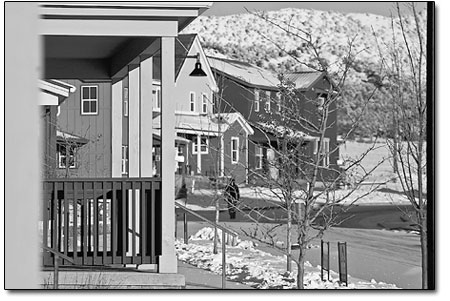| ||
Raising a village
by Jennifer Carter It was billed as a better kind of suburb, a physical setting that would give rise to a more community-oriented, environmentally friendly way of life. Nearly four years after the Durango City Council approved annexation and a comprehensive plan for the Three Springs development in Grandview, the first homes are on the market. Today, Three Springs is a little more than a dozen densely clustered new homes and a row of business and retail spaces that jut up from otherwise wide-open land just east of the Mercy Regional Medical Center campus. In about 20 years, plans call for a 681-acre development, including more than 2,200 residences and more than 800 square feet of commercial space, trails, parks, two public schools and a large, regional park. Admirers say Three Springs’ unusual development style aims to combat the pitfalls of suburban life – sprawl, social isolation and car-dependence. Detractors worry that there’s no way to keep a development of its size from changing Durango’s pace and ambiance for the worse. The front porches of the first clusters of houses face each other across small, shared squares. From the windows of one of the new homes, the neighbors’ houses look nearly close enough to reach out and touch. What residents give up in back yards, they’ll gain in shared green space, according to plans for the development. Streets are narrow to keep traffic slow and make walking and biking more comfortable, and garages sit out of view at the backs of the houses instead of dominating the fronts. Three Springs is the first project for Tierra Group, LLC, a home construction division of the Southern Ute Tribe’s Growth Fund. With Three Springs, the group is aiming to mimic the look and feel of Durango’s older, more walkable inner-city neighborhoods, said Tierra spokesman Tim Zink. “If you’re going to replace a beautiful valley, which is what this is, you want to replace it with something that’s worthwhile,” Zink said. The approach, called “traditional neighborhood development,” grew out of the New Urbanism or Smart Growth movement, a reaction to suburban sprawl. It combines dense residential development with nearby small retail and business spaces, narrow streets and an unusually large amount of shared trails and green space. The configuration is supposed to encourage walking, the use of alternative transportation, more interaction with neighbors and shopping close to home. Zink said the group’s embrace of smart growth principles has also smoothed the way for cooperation with the city, La Plata County, the medical center and the state Department of Transportation, which worked with the developer to improve the intersection of Highway 160 and the entrance to the development. “It’s much easier to get everyone going in the same direction when everyone believes in the concept,” he said. With the first houses complete, Durango Mayor Doug Lyon thinks the group is on track. “They are delivering what they promised to deliver,” said Lyon, who sat on the Planning Commission that approved the original plans for the development. “And they promised a lot.” Lyon said it was easy to support the Three Springs proposal after he compared plans for the development with his own downtown Durango neighborhood. “I certainly did not want to build anything that you would call suburban sprawl,” he said. “It would be totally inappropriate for our community.” Three Springs more closely resembles the downtown historical district, where residents can find a bagel or a quart of milk without taking their car out, Lyon said. “We’re getting something that is compatible with what we know of as Durango,” he said. But not everyone is swayed by Three Springs’ “Traditional Neighborhood Development” credentials. “I think it’s a marketing tool,” said Durango City Councilor Renee Parsons. “It’s really nothing more than that.” Parsons said she’s partly worried about the cost to taxpayers to provide urban services to a large new development, but she’s more concerned about the effect on the tempo of life in Durango. Parsons said she appreciates efforts to create a more sustainable development, but the project is nonetheless the largest the city has undertaken. She said she thinks such large-scale growth inevitably will strain Durango’s sense of community rather than improve it. “How big a city do we really want Durango to be?” she said. “How urban do we really want to be? “Most of us came here for the quality of life,” she added. “But there’s a threshold where we lose that quality of life that brought us here in the first place as these kind of mega-developments happen.” Plans call for Three Springs to reach its full size in about 20 years with businesses that could include a small grocery store and an assisted-living facility. However, market forces could slow or hasten that growth, Zink said. Nonetheless, Alpine Bank has already agreed to open a branch in Three Springs’ retail district, and Zink said the group is seeking agreements with other businesses. As the first Three Springs homeowners move in, Zinc said only time will tell if the traditional neighborhood approach will attract homebuyers and businesses owners. “We are not the ultimate solution for everyone,” he said. “We are an alternative.” •
|


